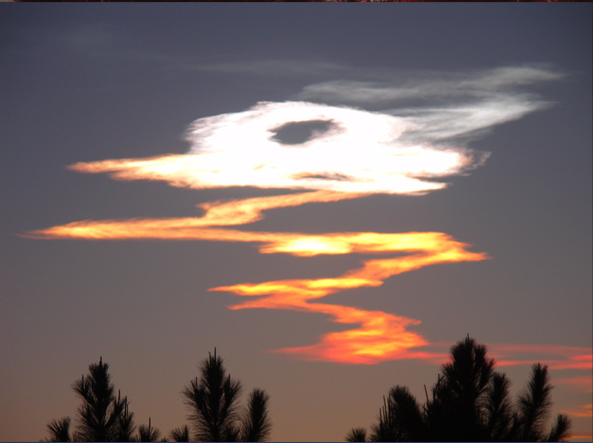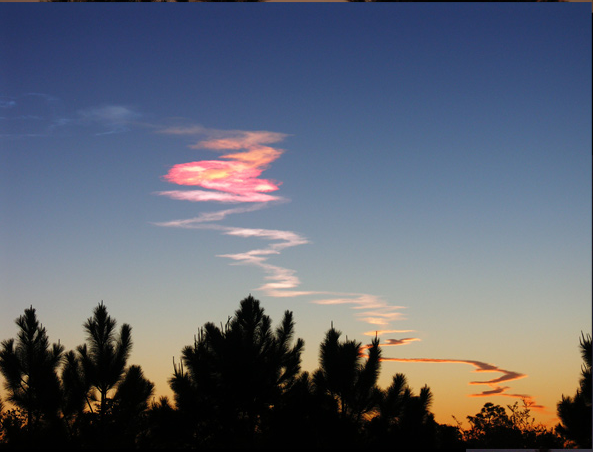STS 131 Night Shining Clouds
STS 131 Night Shining Clouds: A Mesospheric Spectacle
In the early morning hours of April 5, 2010, the STS 131 space shuttle launched into the dark sky, carrying with it the promise of scientific exploration. As the shuttle soared through the atmosphere, it encountered a unique phenomenon known as night shining clouds (NLCs), which captivated observers across the Tampa Bay region of Florida, approximately 130 miles from the launch site. These awe-inspiring clouds, captured by photographer Martin Zloty, showcased the remarkable interplay between sunlight and atmospheric conditions at high altitudes.
The Mesosphere: A Cold and Dry Region
As the STS 131 rocket broke into high altitude sunlight a few minutes after liftoff, it ventured into Earth's mesosphere. This region, located between 30 and 50 miles above the Earth's surface, is characterized by its extreme cold and dryness. The mesosphere experiences minimal heating from solar radiation absorbed by ozone, resulting in frigid temperatures. Moreover, the density of the atmosphere at this altitude is approximately one millionth or less than that at ground level.
Water Vapor and Ice Crystal Formation
During its ascent, the STS 131 rocket generated copious amounts of water vapor through the combustion of its engines. In the mesosphere's cold and dry environment, this water vapor quickly condensed into ice crystals, giving rise to the night shining clouds observed during the launch. Unlike typical noctilucent clouds (NLCs), which possess a reticulated and skein-like structure and solely reflect sunlight, these clouds exhibited a faint iridescence. The larger ice crystals in this cloud grew rapidly in close proximity to the vehicle before expanding significantly.
The Transient Brightly Glowing Cloud
One notable feature captured in Zloty's photographs is a transient brightly glowing cloud situated below the main cloud formation. This phenomenon warrants further explanation. Additionally, the conditions in the upper atmosphere that facilitated the formation of such large and abundant ice crystals during the STS 131 launch are of great interest.
To comprehend the transient brightly glowing cloud, it is crucial to consider the influence of high altitude winds. The lower altitude exhaust trail, contorted and twisted by these winds, is illuminated by the impending dawn on the ground. As sunlight traverses downwards through Earth's dense lower atmosphere and then upward again to reach the exhaust trail, it undergoes intense reddening. The upper portion of the trail, exposed to a higher sun, shifts in color from yellow to white.
Exploring Upper Atmospheric Conditions
Understanding the atmospheric conditions that led to the formation of the remarkable night shining clouds during the STS 131 launch requires a deeper investigation. Several factors likely contributed to this spectacle:
- High Altitude Sunlight: The presence of sunlight at high altitudes played a crucial role in illuminating the ice crystals, allowing them to scatter and diffract light.
- Rocket Exhaust: While solid-fueled rockets can produce vivid high altitude iridescence through the scattering and diffraction of sunlight by their exhaust smokes, it is unlikely that this was a significant factor during the STS 131 launch, as the boosters were depleted before reaching sunlight.
- Atmospheric Dynamics: The interplay between temperature, pressure, wind patterns, and other atmospheric dynamics in the mesosphere likely contributed to the formation of larger ice crystals during this particular launch.
Conclusion
The mesmerizing display of night shining clouds during the STS 131 launch captured the imagination of onlookers. These unique clouds, formed by the rapid condensation of water vapor into ice crystals in the frigid and dry mesosphere, exhibited a faint iridescence unlike typical noctilucent clouds. The transient brightly glowing cloud, illuminated by the dawn on the ground, added an extra element of wonder to the spectacle. Exploring the atmospheric conditions that allowed for the formation of such large and abundant ice crystals during this launch provides valuable insights into the dynamics of our upper atmosphere. The STS 131 night shining clouds serve as a reminder of the intricate and captivating phenomena that occur above us in the vast expanse of the sky.

Shuttle Clouds ~ Clouds generated by night launched STS 131 after it burst into high altitude sunlight on April 5, 2010. All images taken by Martin Zloty across Florida in the Tampa Bay region some 130 miles from the launch site.
©Martin Zloty, shown with permission.

STS 131 launched at 06:21am EDT into a dark sky with the sun deep below the ground horizon. Some three minutes into the flight it broke into high altitude sunlight and from then on produced a varied display of atmospheric effects.
That at top is the last one as, with the main hydrogen and oxygen powered engines still burning, it powered through Earth's mesosphere where the remaining atmosphere is one millionth and less of the density at the ground.
The region is intensely cold because there is little heating by absorption of solar radiation by ozone and it is also very dry. In those conditions the tonnes of water vapour generated by the engines� combustion significantly alter the surrounding atmosphere�s composition. The water vapour quickly condenses into ice crystals and it is these that are scattering sunlight.
The mesosphere is the region where noctilucent clouds form but this enormous cloud is not quite 'noctilucent' even though it is �night shining�. It differs in form, NLCs have reticulated and skein-like structure, plus it is faintly iridescent. NLCs are made of minute ice crystals too small to iridesce and are purely the colour of sunlight. This cloud is made of rather larger ice crystals that must have grown quickly close to the vehicle before the water cloud expanded significantly.
At left the lower altitude exhaust trail, contorted and twisted by high altitude winds, is lit by a dawn yet to come on the ground. Sunlight has passed downwards into Earth’s dense lower atmosphere and then out and up again to light the trail. During that passage it was intensely reddened. The upper trail shifts to yellow and then white because it was illuminated by a higher sun.
Night launched solid fuelled rockets can give vivid high altitude iridescence as their exhaust smokes scatter and diffract sunlight. This is unlikely to have contributed much here as the boosters were exhausted before the craft reached sunlight.
The transient brightly glowing cloud below needs explanation. Also, why did this launch produce such a spectacle? What were the conditions in the upper atmosphere that allowed such large and copious ice crystals to form?


Note: this article has been automatically converted from the old site and may not appear as intended. You can find the original article here.
Reference Atmospheric Optics
If you use any of the definitions, information, or data presented on Atmospheric Optics, please copy the link or reference below to properly credit us as the reference source. Thank you!
-
<a href="https://atoptics.co.uk/blog/sts-131-night-shining-clouds/">STS 131 Night Shining Clouds</a>
-
"STS 131 Night Shining Clouds". Atmospheric Optics. Accessed on November 22, 2024. https://atoptics.co.uk/blog/sts-131-night-shining-clouds/.
-
"STS 131 Night Shining Clouds". Atmospheric Optics, https://atoptics.co.uk/blog/sts-131-night-shining-clouds/. Accessed 22 November, 2024
-
STS 131 Night Shining Clouds. Atmospheric Optics. Retrieved from https://atoptics.co.uk/blog/sts-131-night-shining-clouds/.